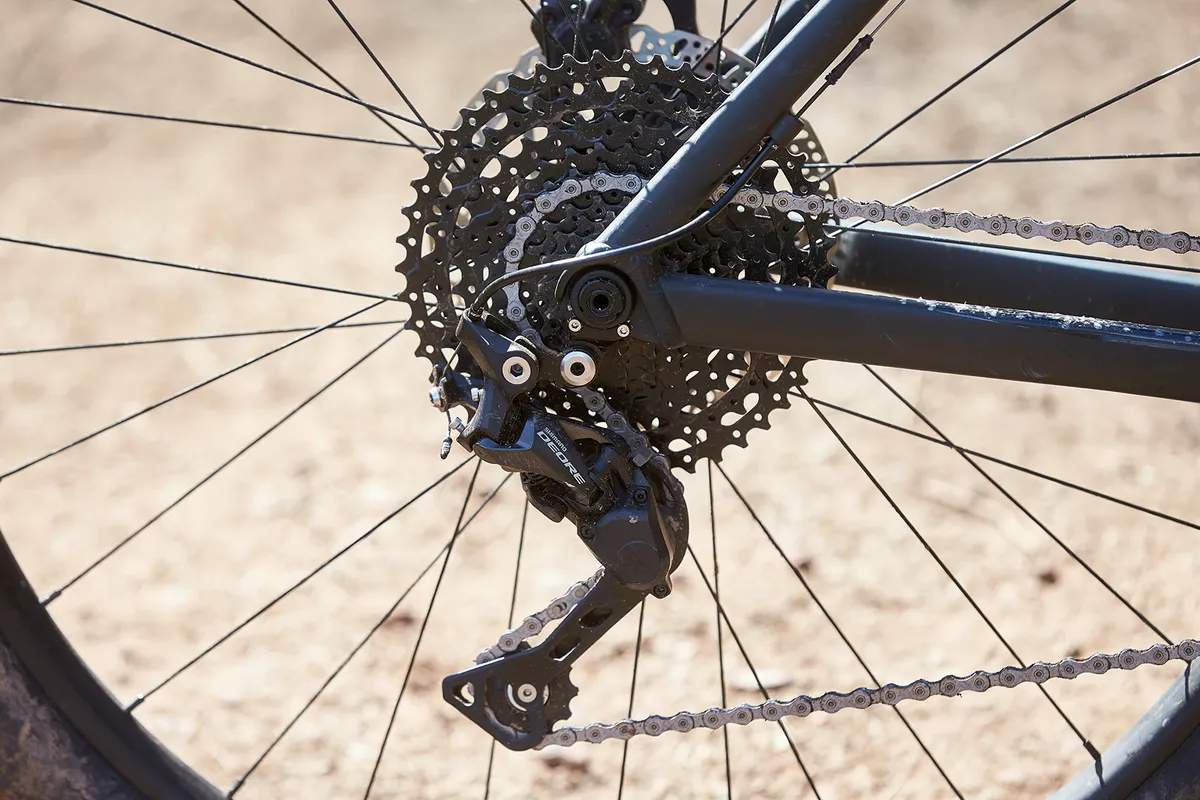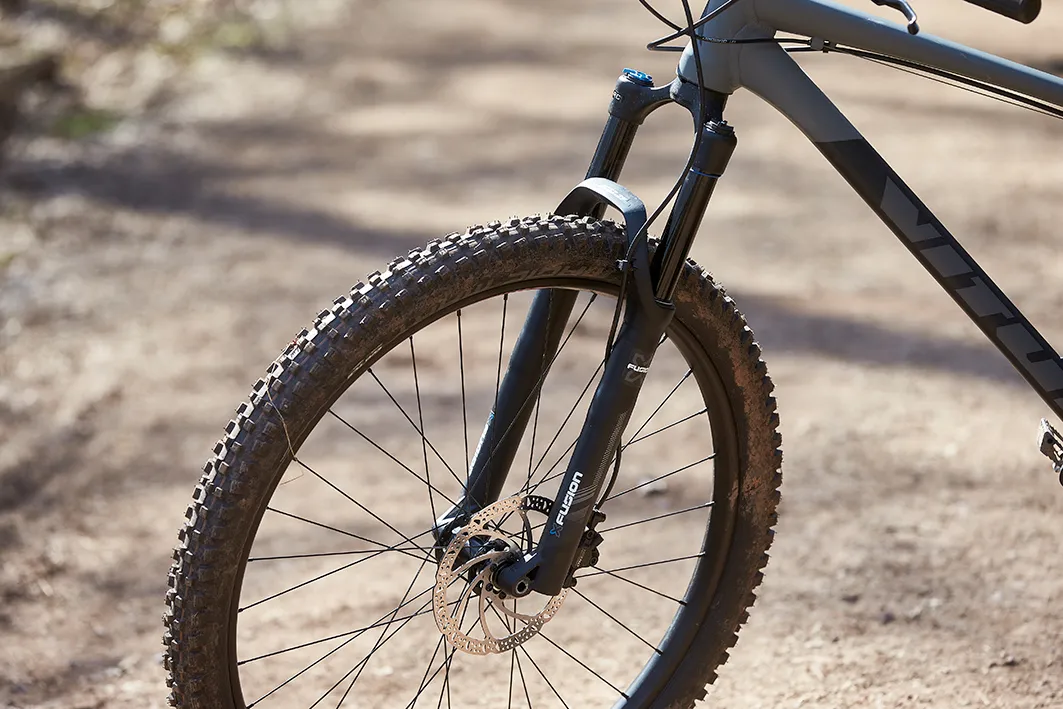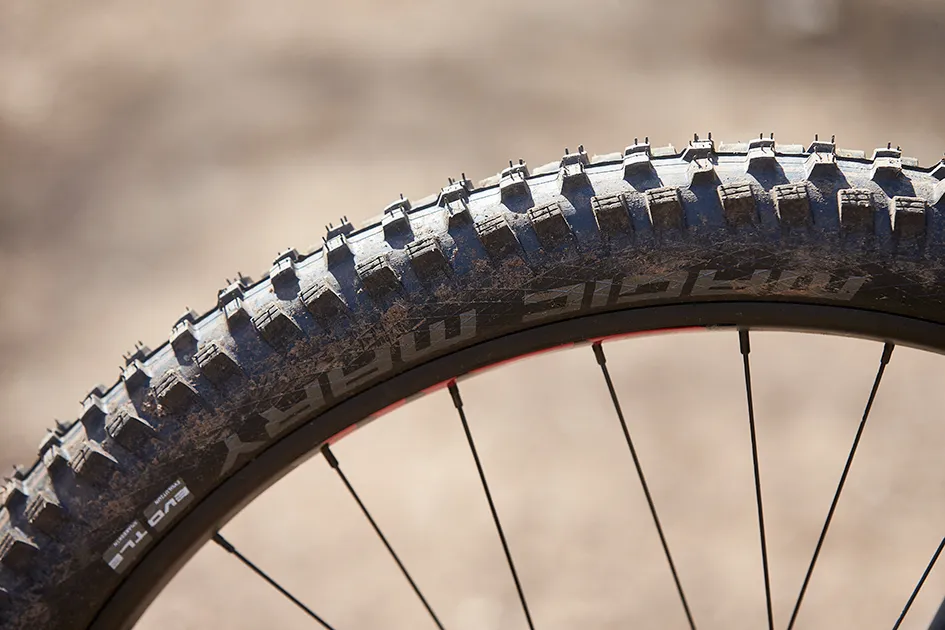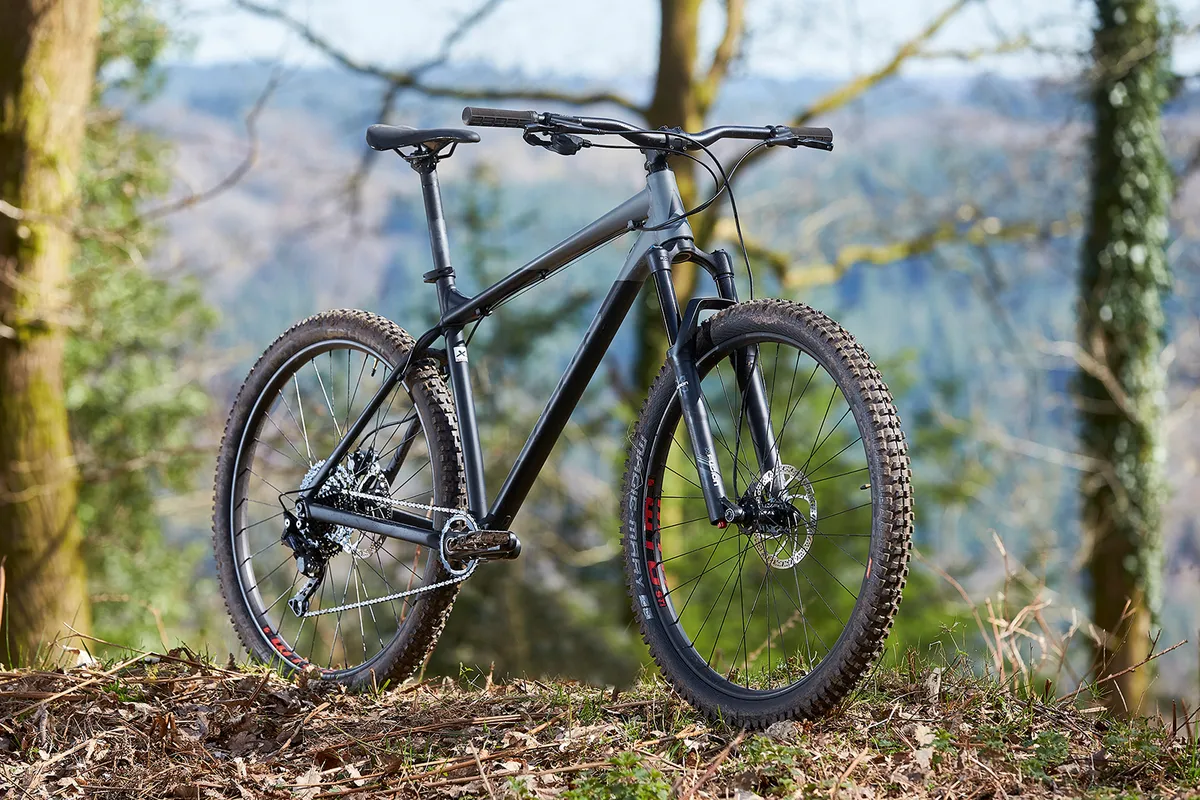By combining well-chosen parts with well-balanced geometry, Vitus has created a fun and versatile bike in the Sentier.
But the fork doesn’t work as well for heavy riders as it does for lighter ones, and those who want to tackle steep and technical terrain may want slightly longer, more stable geometry.
Vitus Sentier 29 frame
The Sentier was tested against two other top-value hardtails, the Specialized Fuse 27.5 and Calibre Line 29, and was the only bike to have ISCG tabs on the bottom bracket shell for attaching a chain guide – not that you’re likely to need one these days, with chain-taming clutch mechs and narrow-wide chainrings now ubiquitous.
There are cable bosses for a front mech too. You never know, they might make a comeback!
The rear mech’s inner cable is left exposed on the seatstay and under the top tube, which means it’s likely to get sticky sooner. And if you want to fix this by fitting a full-length outer cable, you’ll have to crudely zip-tie it next to the cable bosses because the frame isn’t designed for it.
The lack of chainstay protection is an obvious omission too, but one that’s pretty standard at this price and easily addressed. On the plus side, there’s internal cable routing for a dropper post should you want to upgrade in future.
Vitus Sentier 29 kit

Although missing a dropper, the Sentier’s low asking price and quick-release seat clamp (which lets you quickly lower or extend the stock rigid seatpost manually) make this easy to overlook.
The 10-speed Shimano Deore-based drivetrain with its 11-46t SunRace cassette matches the gear range of the 11-speed Calibre. Combined with a 30t chainring, it provides a good spread.
Tektro’s M290 brakes provide ample stopping power and a consistent lever feel. Wide and tubeless-ready WTB wheels are a great choice too, as are the grippy yet surprisingly fast-rolling Schwalbe tyres.

You get a 50mm stem and 800mm bar, which suit the bike perfectly; you can always cut the bar down if needed.
The only quirk is the X-Fusion RC32 fork. While it’s well-damped and reasonably stiff, the negative spring isn’t self-adjusting (as it is on RockShox forks). That means it’s disproportionately firm at the start of the travel if you put more than about 80psi in the main spring.
This won’t be a problem for lighter riders, because it works great at lower pressures, but at 90kg (14st 2lb), I was stuck with a fork that was either reluctant to break into the start of its travel or simply too soft.
Vitus Sentier 29 ride impressions
The Sentier isn’t the longest or slackest bike, but with a decent amount of stack and reach, combined with the 50mm stem and wide bar, the XL size feels relatively roomy.
That wide bar and the generous space between the saddle and grips make for a comfortable and efficient climbing position, whether seated or standing.
At 13.26kg, it was the lightest bike on test by about a kilo, which certainly doesn’t hurt. Even with a dropper post it’d still be respectably light.
I found that the 30-46t lowest gear offered enough leverage for the most demanding climbs. While the drivetrain generated a grinding noise when pedalling hard in second or third gear, this quietened down with time and after re-lubing the chain.
The 74.3-degree seat-tube angle is good and steep, which makes it easier to control the front wheel on technical climbs. However, with the fork set to the right pressure for my weight, it was over-keen to fully extend when climbing, which made it harder to keep the front wheel tracking.
The Sentier covers ground well though, thanks to the surprisingly fast-rolling rear tyre and impressively slick shifting from the Deore/SunRace 10-speed gearing.
While the lack of a dropper post soon gets old when riding rolling terrain, this is easily fixed if and/or when you can afford it.
Once you start going downhill, the X-Fusion fork’s unwillingness to engage its early travel can make it harder to maintain traction in loose, flat turns. But this won’t be an issue for lighter riders, and once you get over the front or start using the brake, so that the fork is loaded up and into its travel, it soaks up bumps like a model well above this price range.

The Tektro brakes are impressive too, with plenty of power and intuitive ergonomics, even on steep descents.
Best of all, the tyres grip nicely in typical UK conditions such as mud, loam and greasy hardpack trails. And because the front is grippier than the rear, the back end usually breaks away first, giving grin-inducing confidence to let the rear wheel slide on loose terrain.
The rear tyre comes with Schwalbe’s tougher Double Defence casing, so it should take a beating without puncturing, and both tyres and rims should be simple to set up tubeless.

The Sentier’s head angle is on the steep side – I measured it at 66.9 degrees – and the 1,210mm wheelbase isn’t radically long for a modern XL bike. This makes the handling a little livelier, but less confident, than that of slacker trail hardtails, such as the Calibre Line 29.
I still felt far more comfortable descending at speed on the Vitus than on the Specialized, though. This is partly down to the supple fork (once you’re past any initial resistance), punchy brakes and grippy tyres, but the higher, roomier and wider cockpit is the main reason for this.
Although the geometry doesn’t exactly beg you to ride the bike headlong into technical terrain, the plucky Sentier handled everything I threw at it just fine. Compared to more stable bikes, it just takes a bit more finesse and some careful line choice to make it through quickly and safely, along with a slightly more rearward body position.

While the Vitus may not feel quite as unshakeable as some of its rivals, the snappier handling will suit those who want to ride mellower trails or even the occasional pump track, rather than tackle technical descents all day.
It’s easy to get the Sentier to corner sharply, particularly for those who aren’t used to the more rider- forward riding style required for today’s longer bikes.
Vitus’s size guide is a little optimistic in suggesting that the XL will fit riders from 190cm / 6ft 3in to 201cm / 6ft 7in tall; at 190cm exactly, I’d have preferred more length between the wheels to calm the handling.
Sizing-up could allow some riders to get a more confident-feeling ride, but be careful, because the seat tubes are long. If you can size-up, or just like a slightly more traditional-handling bike, the Sentier is a great choice.
Vitus Sentier 29 geometry
- Sizes (* tested): M, L, XL*
- Seat angle: 74.3 degrees
- Head angle: 66.9 degrees
- Chainstay: 43.5cm / 17.13in
- Seat tube: 52cm / 20.47in
- Top tube: 66cm / 25.98in
- Head tube: 13cm / 5.12in
- Fork offset: 5.1cm / 2in
- Bottom bracket drop: 6.15cm / 2.42in
- Bottom bracket height: 31cm / 12.2in
- Wheelbase: 1,210mm / 47.64in
- Stack: 66.1cm / 26.02in
- Reach: 46.8cm / 18.31in
How we tested
This bike was tested as part of a three bike grouptest of top-value trail hardtails priced at under £1,000.
Luckily, we measured-up, tested and shot these bikes before the UK went into Covid-19 lockdown. There wasn’t time to thoroughly test a fourth bike to our usual standards, however, but if you want the most capable trail bike for under a grand, you should be well served by these bikes.
Bikes also on test:
Product
| Brand | Vitus |
| Price | A$1400.00, €950.00, £850.00, $950.00 |
| Weight | 13.26kg |
Features
| Fork | X-Fusion RC32, 130mm (5.1in) travel |
| Stem | Vitus, 50mm |
| Chain | KMC X10 EPT |
| Frame | 6061 aluminium alloy |
| Tyres | Schwalbe Magic Mary SnakeSkin ADDIX Soft (f) and Schwalbe Nobby Nic Double Defence RaceGuard ADDIX (r) 29x2.35in |
| Brakes | Tektro M290, 180mm rotors |
| Cranks | SR Suntour Zeron, 30t |
| Saddle | Nukeproof Neutron |
| Wheels | WTB ST i30, 30mm internal |
| Headset | Acros ZS44 |
| Shifter | Shimano Deore |
| Cassette | SunRace, 11-46t |
| Seatpost | Vitus rigid |
| Grips/tape | Vitus lock-on |
| Handlebar | Nukeproof Neutron, 800mm |
| Bottom bracket | SRAM GXP, external |
| Available sizes | M, L, XL |
| Rear derailleur | Shimano Deore (1x10) |
| Features | Hubs: Vitus M5ER Axles: 15x110mm Boost (f) / 12x148mm Boost (r) Spokes count: 32 |


